
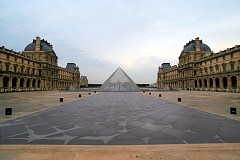
|
Monday October 1, 2007
Here in the Louvre courtyard looking west is the pyramid covering the entrance to the Louvre museum
(blue-circle-1 on the map). It's a threat-of-rain morning, and the Louvre has not
opened yet.
Once the Tuileries Palace closed the western end of the Louvre
courtyard, which has remained unclosed since the destruction of the palace in 1871.
In this picture, you can imagine it filling the space between the buildings
just beyond the Pyramid.
|
|
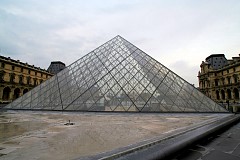
While the pyramid over the Louvre entrance is distinctive, I really don't
find it particularly attractive.
|
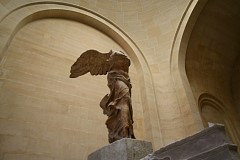
At the top of the Daru staircase in the Denon Wing is the eleven foot tall
statue Winged Victory of Samothrace.
When found on the Greek island of Samothrace in the 19th Century it was in thousands of pieces.
and was re-assembled at the Louvre. It depicts Nike, the goddess of victory, and
dates from around 190 BC.
The work was meant to be viewed from the front left-hand side. This explains why the right side of the body is less detailed.
Before losing her arms, which have never been recovered, Nike's right arm was raised. The work is
notable for its naturalistic pose and for the rendering of the figure's draped garments, depicted as if rippling in a strong sea breeze.
The statue’s outstretched right wing is a symmetric plaster version of the original left one. Various other fragments have since been found: in 1950 one of the statue's hands was found on Samothrace and is now in a glass case in the Louvre next to the podium on which the statue stands.
|
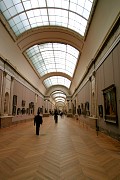
The Louvre is divided into three main wings:
Richelieu (North),
Sully (East), and
Denon (South - running parallel to the river Seine). Here in the Denon, I am slowly
heading toward the Mona Lisa.
You will note the line of a low railing close to the floor along the wall. Over the years, crazy
people have attacked paintings for their own bizarre reasons. There
are motion detectors everywhere, and if you penetrate past the railing and the wall
an alarm sounds. I managed to trip the alarm
once during my visit while manipulating my camera
and not being careful.
|
|
The pictures that follow are not "great". They are taken just to document the
experience. Frames sticking out from the surface of the painting often confuse
the camera focus. So too do light sources which illuminate the paintings, and
the angles I take the pictures at. You'll just have to come see the real thing.
|
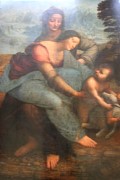
Leonardo da Vinci (1452-1519)
Madonna and Child with Saint Anne - between 1508 and 1513
St. Anne is the mother of Mary Magdalene, the mother of Jesus. She
holds Mary on her lap, who in turn holds baby Jesus. In the precursor
sketch of the painting, the lamb is baby John the Baptiste. I thought
the mountainous background a bit bizarre given my limited knowledge of the terrain
of the holy land. Secondly, I like the treatment - the detail - of the feet
of the women.
|
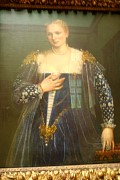
Paolo Caliari (aka Paolo Veronese) (1528-1588)
The Beautiful Nani - 1555
This is a masterpiece from the Venetian Portraiture period 1475-1575.
In 1543 the Venetian Senate had decreed that no low woman could wear jewelry or
expensive clothes.
The reason given for this decree is that these women "are so well dressed and adorned that on many occasions our noble and citizen women have been confused with them".
We may assume that the woman in this portrait, who looks pregnant to me, is indeed a Lady.
To be blonde seems to have been the cosmetic aspiration of most women in Venice as Cesare
Vecellio wrote in 1590:
"On the roofs of Venice are wooden altanas where women dye their hair blonde. It is there, that with a lot of skill and assiduity, if not all, at least most of the Venetian women dye their hair blonde with diverse sorts of waters prepared for this effect.
|
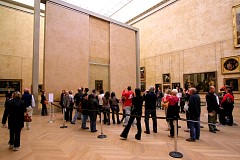
People are already starting to congregate before the Mona Lisa. A big announcement about the
painting was made a few months after my visit.
The painting is also known as "La Gioconda" meaning the happy or joyful woman in Italian,
a title which also suggests the woman's married name.
Lisa Gherardini, the wife of a wealthy Florentine merchant, Francesco del Giocondo, has long been seen as the most likely model for the sixteenth-century painting.
But art historians have often wondered whether the smiling woman may actually have been da Vinci's lover, his mother or the artist himself.
Now experts at the Heidelberg University library say dated notes
made by a Florentine city official Agostino Vespucci, an acquaintance of the artist, solve
the mystery.
The comments compare Leonardo to the ancient Greek artist Apelles and say he was working on three paintings at the time, one of them a portrait of Lisa del Giocondo.
|
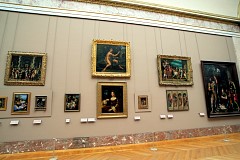
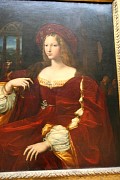
Raphael (1483-1520) and Giulio Romano (1492-1546)
Portrait of Dona Isabel de Requesens, vice queen of Naples - 1519
I am still in the Denon Wing.
Here is the painting as it hangs on the wall (left) and a close-up (right).
It is believed that Raphael painted the face of the vice-queen after going to Naples to
sketch her, and that his chief assistant Giulio Romano did the rest.
I just liked the variations of red seen in the dress.
|
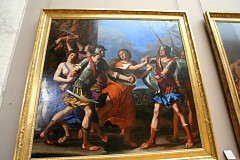
Giovanni Francesco Barbieri (called Guercino) (1591-1666)
Hersilie between Romulus and Tatius, also The battle of the Romans and Sabins - 1645
The rape of the Sabine women is a popular subject for artists. Here, "rape" means
abduction. The early Romans had no wives, and the local Sabine people would not
allow their women to marry Romans. They were fearful the Romans would take over
the area and culture (which they did). The Romans invited the Sabins to the festival of Neptune Equester, then
kidnapped the women. Basically, the Romans convinced the women to willingly marry them.
Hersilie became the wife of Romulus.
Later, when the Sabins and Romans fought, the Sabin women got between the parties
and stopped the war.
|
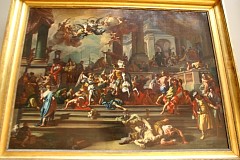
Francesco Solimena (1657-1747)
Heliodorus ousted from Temple - 1725
It seems Heliodorus, collecting taxes on behalf of the Jewish king to give to the Romans,
is looting the Temple in Jerusalem. Suddenly he is
struck blind and driven out by angels on horseback. I liked the use of red, blue, and gold
colors and the details in the individuals in the crowd. This painting was done as the precursor to
a mural Solimena painted in the Church Of Gesu Nuovo, Naples, Italy. This explains the need for
so many detailed objects i.e. the crowd.
|
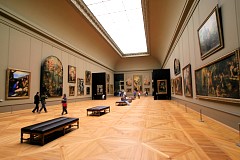
This picture is out of focus, but I include it to show the benches provided and used
to gawk at the art. It's not tourist season, and soon after opening, so it's not
crowded at all.
|
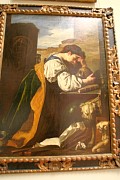
Domenico Fetti (1589-1623)
Melancholy (1618-23?)
Fetti is a Baroque painter who's works some compare to those of Peter Paul Rubens.
I find it strange that in the painting it's a melancholy woman cradling the skull,
not a man. All color is subdued. Maybe if she forgot about the skull and played with
the dog she would feel better.
|
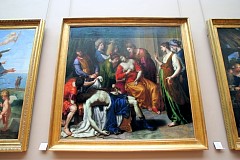
Alessandro Turchi (1578-1649)
The Death of Anthony and Cleopatra, (1630-35?)
I like the quote, "The true history of Antony and Cleopatra will probably never be known; it is buried too deep beneath the version of the victors". If you get a chance to view the HBO series Rome,
I highly recommend it for it's treatment of the same subject. Perhaps this is what drew me to this painting. It could also be the vivid colors, or, let's face it, female nudity above the waist.
|
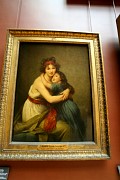
Elizabeth-Louise LeBrun (nee Vigée) (1755-1842)
Self-Portrait with Daughter (1789)
In 1776, she married Jean-Baptiste-Pierre Le Brun, a painter and art dealer.
She painted portraits of many of the nobility of the day and as her career
blossomed, she was invited to the Palace of Versailles to paint Marie Antoinette, the French Queen consort.
So pleased was the queen that over the next several years, Vigée-Le Brun was
commissioned to do numerous portraits of the queen, her children, and other
members of the royal family and household.
I just liked the captured sentiment of mother and child. Vigée-Le Brun left a legacy
of 660 portraits and 200 landscapes.
|
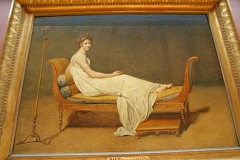
Jacques-Louis David (1748-1825)
Madame Recamier (1800)
Jeanne-Françoise Julie Adélaïde Bernard Récamier (1777-1849), known as Juliette, was beautiful
and presided over elegant society in Paris until she was banished from France in 1811.
She was married at
fifteen to Jacques Récamier (d. 1830), a rich banker more than 30 years her senior.
He lost most of his money in 1805, and she afterwards endured reduced circumstances.
I like the starkness of this painting - just Juliette and a few items. There is no doubt
that she is the focus of the painting, and any additions in the background would only distract attention
away from her. The piece of furniture she reclines on is nowadays called a Recamier.
|
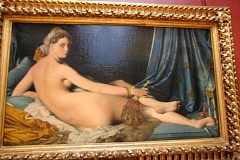
Jean Auguste Dominique Ingres (1780-1867)
La Grande Odalisque (1814)
An odalisque is a concubine or female slave in a harem.
The painting has been criticized because it is said the woman has three lumbar vertebrae too many.
I found one source that actually conducted experiments measuring women volunteers, which found
the Odalisque's back is longer than normal by the height of almost five, rather than just three,
lumbar vertebrae; also, contrary to received wisdom, the excess affects the lower back and the pelvis, rather than being confined to the lumbar region.
Add a final anatomical insult: the left arm of the Odalisque is shorter than the right.
In fact, this painting is so bad, the Louvre should just remove it from
their collection and send it to me. His student was
Chasseriau
|
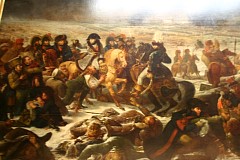
Antoine-Jean Gros (1771-1835).
Napoleon on the Battlefield of Eylau (1808)
In 1793 Gros went to Italy, where he met Napoleon and was appointed his official battle painter. He followed Napoleon on his campaigns, and painted these dramatic but fantciful scenes showing
a caring Napolean overlooking the carnage he has caused. I am always drawn to the details
of individuals when there are large numbers of them such as in a painting like this.
Note in the right corner
a glowering Prussian soldier is led away.
|
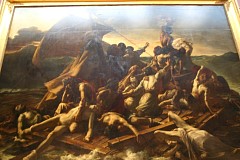
Theodore Gericault (1791-1824)
The Raft of the Medusa (1819)
This painting was a not-so-subtle criticism of the restored monarchy that took over France
after the fall of Napoleon. The Royalist captain left his grounded ship with the
important people leaving 86 people behind. Only 15 survived. There is no single hero
in this picture, it's misery that's portrayed as heroic. The artist studied bodies
in the morgue in order to get the look of various stages of life and death. Ingres, the
vertebrea transgressor (La Grande Odalisque, two pictures above), hated this painting.
|
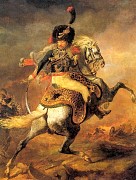
Theodore Gericault (1791-1824)
The Charging Chasseur (1812)
Quite frankly, I am drawn to this painting because of the depiction of the uniform.
I tried to visit the Napoleonic era portion in the Amy Museum, but it was closed.
This is as close as I got to seeing uniforms. I want one of those giant hats -
do you suppose it hurts your neck to wear one all the time?
|
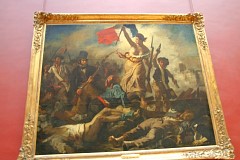
Eugene Delacroix (1798-1863)
Libery Leading the People (1830)
This painting has been described as the "first political composition in modern painting."
"Libery" wears on her head the soft, red, conical Phrygian cap identified with the Jacobins
during the French Revolution of 1830.
The artist remained in hiding during the unrest, but saw fit to include himself, the
man in the top hat, in the painting. Notre-Dame is visible in the background.
I liked "Liberties" barefoot feet - wasn't there any sharp rubble in the streets?
|
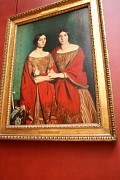
Theodore Chasseriau (1819-1856)
The Artist's Sisters (1843)
I noticed this picture because the women are similar, but not identical.
|
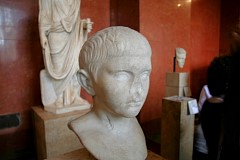
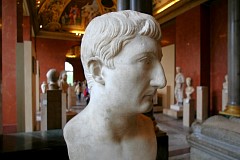
I am not a statuary guy, but I like the realism in these busts.
|
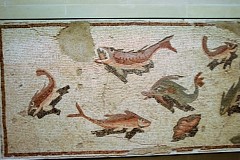
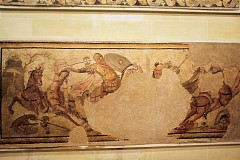
I really liked these mosaics. I would not like to haul in any of the fish depicted here.
In the picture on the right, it seems to me the central figure is wearing Roman armor.
|
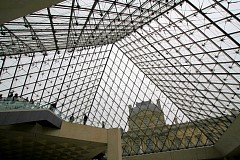
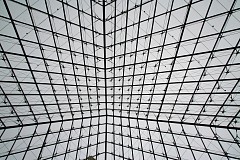
As you enter the Louvre you descend to a common area from which you can enter each
of the three wings. I am between wings, looking up through the Pyramid of the Louvre.
|